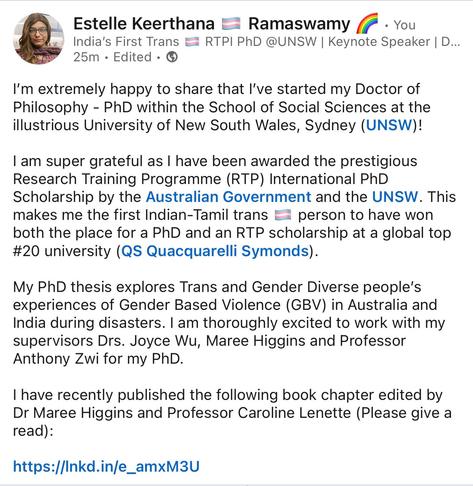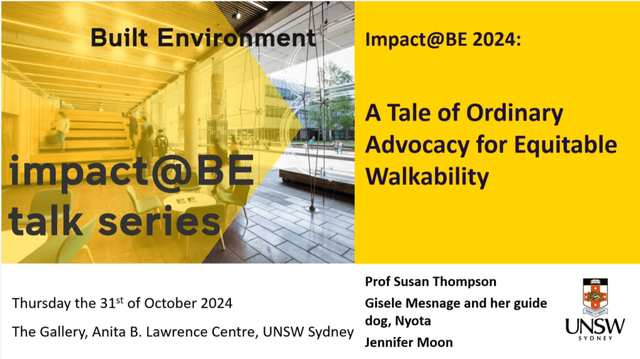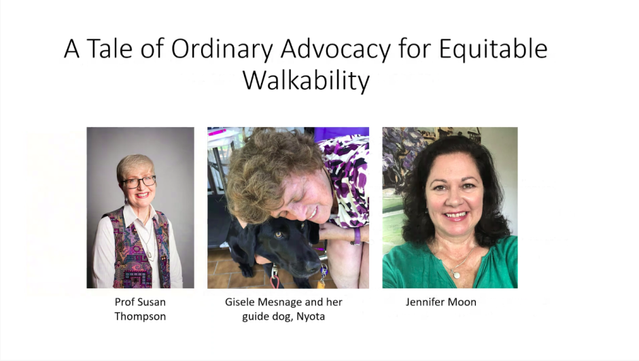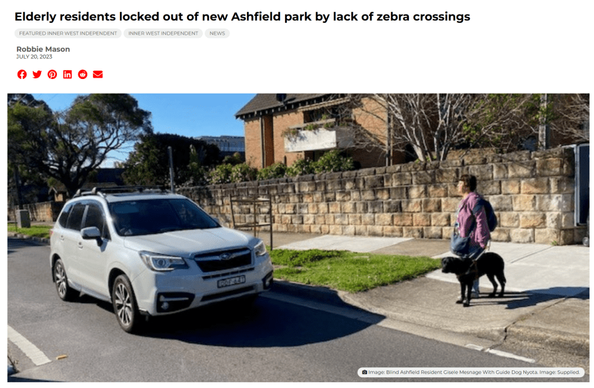Great to see initiatives championing diversity in engineering! The 2025 UNSW Women in Engineering Awards are a top example, celebrating vital contributions of women, non-binary & gender-diverse talent. Recognition is key to inspiring future STEM innovation.
#WomenInEngineering #DiversityInSTEM #UNSW
RE: https://bsky.app/profile/did:plc:2r5lbx2yezdyyedqmmps6ckk/post/3loze24llns2d
#UNSW
What is it like for international students doing PhDs in Australia?
In this video I sat down with Ranni from Indonesia to hear her experience with her PhD in educational psychology at UNSW.
#UNSW #Indonesia #Indonesian #PhD #InternationalStudent #University
youtu.be/nCrN100LpWo
Come and join me and work in beautiful #Sydney.
We have a new 3-yr research manager #job the #UNSW Micardas radiocarbon lab. Open to Australian citizens only. #Geochronology experience recommended.
https://external-careers.jobs.unsw.edu.au/en/job/532080/research-manager-ncris-radiocarbon
Historical holes: Beneath the surface, caves hold the key to Australia’s wildfire history
My colleague @michcampbell recently held a postdoctoral research grant from AINSE. They've just released this 2025 Research Spotlight for early career researcher awardees all about her fire research. I think this is nicely done. If you'd like to know how caves and cave stalagmites can be used to reconstruct records of past fires, here's the article
#pinesofMastodon :ablobwavereverse: :blobheartraccoon: #botanybay #unsw
🚨 New preprint 🚨
Hydrology and cave (and cave hydrology!) enthusiasts may enjoy this preprint just posted today for community review in the #EGU journal #HESS. Led by former #UNSW student, Christina Song, with @Andbaker and myself, we looked at recharge thresholds (amount of precipitation needed for recharge to occur in a cave), and how they changed after a fire.
https://egusphere.copernicus.org/preprints/2025/egusphere-2025-84/
The preprint is open now for community discussion, and will be accepting comments until 23 April.
Postdoctoral position in climate science at UNSW Sydney
My colleague Andréa Taschetto and I are recruiting. Please share...
Are you familiar with climate model simulations? Are you interested in extreme rainfall events: those that generate groundwater recharge? Are you interested in ENSO?
We are investigating the links between climate drivers such as ENSO, high magnitude rainfall events and groundwater recharge, to help understand how climate drivers affect our groundwater resources.
For more information:
http://andy-baker.org/2025/01/25/postdoctoral-position-in-climate-science-at-unsw-sydney/
#climate #research #Fedijobs #academia #groundwater #climatescience #UNSW
Great #PostDoc opportunity at #UNSW - the successful applicant will use climate model simulations to investigate the climate processes that lead to relationships between climate state, rainfall intensity, and groundwater recharge.
#ECR #ECRChat #AcademicChatter
https://external-careers.jobs.unsw.edu.au/cw/en/job/528547/research-associate
Researchers at the University of New South Wales (UNSW) in Australia, have identified a new method that encodes quantum information onto an antimony atom which can help make errors in quantum systems less likely to occur, and, when they do, make them more easily detected and corrected!
#Physics #QuantumComputing #qubit #QuatumErrors #Schrödingerscat #UNSW #QuantumPhysics
The best thing about still being on #UNSW BEES email lists is getting to see the cute pet application notifications 😍
This 'How to spot a rip' exercise from Prof Rob Brander at #UNSW is excellent.
Anyone who spends time at the beach should be able to ID a rip and know what to do if you get caught in one! In the immportal words of Douglas Adams - DON'T PANIC.
Quietly proud that I spotted all the rips, but living my whole life up until now on the coast, it would have been slightly embarrassing not to have!
"UNSW Sydney has initiated a major collaboration with OpenAI, becoming the first university in the Asia-Pacific region to work with the US-based research organisation to deploy ChatGPT Edu."
I am beyond frustrated with the intrusion of LLMs into higher education and even more disappointed that #UNSW has decided to play ball with these companies.
OpenAI is one of the worst polluters of our information ecosystem. We should not be doing business with them.
https://www.unsw.edu.au/newsroom/news/2024/12/UNSW-Sydney-signs-landmark-agreement-with-OpenAI
🌟 TUTORIAL DETAILS - #LLMs, #LORA and #PEFT 🌟
Join us at #ALTA2024 for a tutorial led by Dr Nicholas I-Hsien Kuo from the UNSW Centre for Big Data Research in Health, #UNSW Sydney.
🌟 What You’ll Gain 🌟
➡️ Implement and evaluate PEFT and quantisation techniques.
➡️ Fine-tune and deploy LLMs on hardware with limited resources.
➡️ Optimise workflows for real-world applications without sacrificing performance.
🌟 Register now! 🌟
https://alta2024.alta.asn.au
If you've ever offset the emissions of a flight at the checkout, you might enjoy this quick presentation from Megan Evans on the greenwashing that happens in carbon markets. Part of #UNSW Festival of Dangerous Ideas.
#carbonCredits #CarbonMarket #emissions
https://unswcentreforideas.com/article/megan-evans-dont-question-fake-carbon-forests
Celebrating Australian Laureate Fellowship Recipients
Last week I had the honour of attending the ARC’s annual Laureate Pin Ceremony, celebrating Australian Laureate Fellowship recipients and Industry Laureate Fellowship recipients. It was wonderful to celebrate with family and meet old and new colleagues. I received my pin in Australia's Parliament House in Canberra from the Federal Member for Canberra, Ms Alicia Payne MP. Over the next five years, I will be building a network of collaborators and training early career researchers to tackle the question of groundwater recharge - that is, the replenishment of groundwater.
http://andy-baker.org/2024/11/16/celebrating-australian-laureate-fellowship-recipients/
#caves #science #groundwater #academia #UNSW #climate #hydrology
The Living Water exhibit at #UNSW closed today. There was just time to show our #groundwater recharge exhibit to my University of Birmingham exchange team. And download the drip logger that counted visitor numbers.
https://www.library.unsw.edu.au/about-unsw-library/exhibitions-program/living-water
New server, new #introduction. Also, hashtags.
I research #transport #access using a lot of GIS, #python, #rstats, #OSM. Formerly #Sydney, Australia, now #Toronto, Canada.
I probably followed you because I liked your thoughts about Australian, French or Canadian #urbanism, #bikepacking, #ebikes, #choralmusic or #rockclimbing, or you work at #UNSW and seem cool.
Je suis aussi capable de toot un peu de l'#urbanisme, #vélo et j'aime suivre ça.
Assisting communities to advocate for equitable walkability
Title slide showing Prof Thompson, Gisele & Nyota, and Jennifer.On 31 October 2024, UNSW Impact@BE (Built Environment) held a webinar featuring:
- Susan Thompson – Professor of Planning, Associate Director (Healthy Built Environments), City Futures Research Centre @ ADA, UNSW.
- Gisele Mesnage – Gisele is blind and her bestie is her guide dog Nyota (which means star, like a guiding star). One of Gisele’s passions is digital accessibility. Gisele also advocates for improved walkability in our cities.
- Jennifer Moon – Guide Dogs NSW/ACT – Social Change team
Session description
The session’s goal was to share how research can be used to support local advocacy – in this case, focusing on equitable walkability for health and wellbeing. This case study involved UNSW research teams writing to council to support better improvements.
At the centre of this specific issue is the design of pedestrian crossings using current urban design trends which alter or eliminate traditional wayfinding cues. This is especially problematic for vision impaired pedestrians.
The experience of crossing roads
Gisele shared how she grew up in a very busy place with no pedestrian crossings / markings. She joined Ashfield Council’s Access committee – to try and campaign to get a crossing. It has taken 14 years to this week to get the first foundations for a crossing!
She described her process of crossing a road. Either
- listen for the tick tick tick sound
- or
- if it’s a zebra crossing – hear / feel the traffic flow and wait for a gap.
If there is a kerb ramp crossing, this is perfect – it is easy to manage, down the slope, stop, cross the road space, and then go back up the slope to the footpath.
However, with new technology and design standards, there are new challenges.
- With flush (continuous) crossings, guide dogs cannot pick out the edge of the footpath vs road (and won’t stop)
- With silent electric cars, it is difficult to hear them.
Gisele described the frustration of a new “fully accessible” park built in Ashfield, but with no crossings to get to the park. She was part of a campaign creating stop signs to help improve access to the park.
Gisele Mesnage, a blind Ashfield resident with hearing loss who lives at Cardinal Freeman Retirement Village with her guide dog Nyota, told City Hub that she has significant difficulties even accessing the park due to a lack of zebra crossings in the surrounding areas.(City Hub, 2023)Other aspects were discussed:
- Digital accessibility – Computers can be difficult for low-vision users
- Luminence contrast (the amount of light reflected from a darker vs lighter building element) can be more effective for a majority of the population, more so than tactile ground surface indicators
- Guide dogs are trained to go around overhanging branches but it can be hard.
- Street design is based on eye contact, but how does that work if you cannot see?
- Designs these days often have no definite “shorelines” (visible edges). 10km shared speed zones with electric vehicles that cannot be heard.
- The cognitive load required to move around this world is immense. The safer it is to move around, the lighter that load is and give people much more capacity to live their lives.
- These issues are increasingly faced by older people, people who can be fearful of going for a walk – because of fast escooters and unpredictable movement on footpath – and the fear of injury. More and more people making these decisions of “I’m not going to go walking any more” is detrimental for physical health, increasing risk for cancers, diabetes, and mental health.
- Light rail is particularly scary – if you couldn’t see and had to rely on 500mm of tactile indicators to stop and make a decision – how safe would you feel? (Sydney’s New Light Rail Causes Concerns Among Disability Groups, 2019)
As beautiful as the dogs are, they’re not magic carpet rides. It’s not “take me to uni”, you have to know where you are.
How universal design can assist
Blind vs Low vision demographics via Vision Australia’s survey (1145 participants)- There are many more low-vision people than blind.
- Ageing generally causes low-vision and we all age!
The panel made it clear that they are not against active transport, but want to focus on creating better solutions and designs that make everyone feel safe.
If you design your environment well, you should be able to design OUT tactile ground indicators.
Design should be intuitive for all people to navigate – not rely on tactiles.
Infrastructure needs to include co-design with diverse groups of people to ensure it works for everyone.
Understanding that flush crossings help accommodate people in wheelchairs and with prams, and despite e-micromobility (eg. e-scooters) causing trip hazards to people, it is not to say we don’t have mobility devices. There are lots of fantastic arguments for sustainability.
But we have to think more broadly. What is the objective? It is not about pitting group vs group. What is our goal and how can we achieve that via equitable and inclusive design?
A blurry screenshot of the presenters on the dayWe all have the same objective – move independently and be healthy – if we have the same objective, we should be able to find an inclusive solution. There has to be a universal solution. It takes time.
The Royal National Institute of Blind People aligns with Guide Dogs NSW/ACT in calling for
- more contrasting (luminence contrasting) designs
- more consistent use of tactiles in all areas to provide more advance warning (noting that tactiles are only useful if they are consistent across people’s journeys and can be confusing in what they indicate – edge? stairs? road?)
- clear separation of people walking from other forms of micromobility and vehicles.
Takeaways
The main footpath issues for people with low-vision or blind, with or without guide dogs:
* Emerging issues (not reported before 2015)
(HVMB = Hostile Vehicle Mitigation Bollards)
Even the researchers were alarmed by the amount of people that reported issues with continuous, at-grade crossings:
How can we work together?
Gisele’s slide showing tips on how the community can advocate for better designsThe new Australian Design Rule (ADR) will require new electric, hybrid and hydrogen fuel cell cars, trucks and buses to be fitted with an AVAS from November 2025.
On a side note, I’m actually currently participating in Transport for NSW’s design project to create a new Acoustic Vehicle Alerting System (AVAS) sound for Zero Emission Buses (ZEBs / electric buses) operating in NSW. It’s been really interesting, so far we’ve been tested for / asked about:
- directional listening
- pleasantness of sound
- distinction with various background sounds (beach, traffic, crowds)
The final sound will be broadcast from external speakers at the front of the bus and change tone as speed changes. Participants have included people walking, blind people and with low-vision, people cycling, bus drivers, bus operators, residents living near bus stops, and passengers.
Brainstorming at the AVAS workshopInternational Day of People with Disability – 3 Dec 2024
Did you know we are in the midst of the Choose Inclusion campaign – Week 3’s focus was Inclusive Access – towards International Day of People with Disability 2024?
https://www.youtube.com/watch?v=A0rLKe6B6j8
For more information about creating a more inclusive world for walking and wheeling, see the Centre for Universal Design Australia (CUDA).
We are also aware of various research programme’s including UTS’ bionic glasses research, ARIA.
WalkSydney’s role
We wish there were more adequate solutions available to solve these challenges of universal urban design to accommodate all users.
Designers, advocates, and community members must continue to advocate for ALL users, and continue listening and learning about challenges, desires and barriers experienced by other community members.
WalkSydney are following all these developments closely and urge designers to include the process of co-design with relevant user groups as a critical part of the process. Overall we again acknowledge that at the end of the day, the frequent reason crossings are unsafe is the motor vehicles, and the ongoing assumption of unaware car drivers as a fixed threat is often leaning into the motornormativity of our world. After all, why should the onus be on blind people to navigate a road crossing safely, and not on sighted car drivers to travel at a safe speed and look out for pedestrians? We recognise the importance of good design to make crossing easier for both parties, but must remember which one is responsible for the danger.
#blind #builtEnvironment #continuousFootpaths #design #footpaths #lowVision #safety #sydney #universalDesign #unsw #walking
Two post-doctoral research positions at UNSW Sydney
Would you like to work at UNSW Sydney with myself (Earth and Sustainability Science Research Centre) and colleagues Andrea Taschetto (UNSW Climate Change Research Centre) and Pauline Treble (ANSTO)? We have two positions being advertised now, both related to the Australian Research Council Fellowship project 'Caves and their stalagmites: linking climate to groundwater recharge'.
http://andy-baker.org/2024/10/31/two-post-doctoral-research-positions-at-unsw-sydney/






